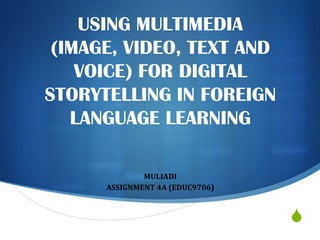Visualising Language Learning
- 1. USING MULTIMEDIA (IMAGE, VIDEO, TEXT AND VOICE) FOR DIGITAL STORYTELLING IN FOREIGN LANGUAGE LEARNING MULIADI ASSIGNMENT 4A (EDUC9706) S
- 2. Outline S What is Digital storytelling? S Digital storytelling as a visual mediaŌĆöthe rationale S The application of digital storytelling toolŌĆöphoto storyŌĆöin EFL/ESL
- 3. What is digital storytelling? S Digital storytelling is not a tool but a technique (e- language, 2013) S An idea of combining a variety of multimedia ŌĆō images, audio, and videoŌĆöto tell a story (Robin, 2006; Choi, 2012) S Using digital media to construct texts to tell, share, and preserve (Digital Storytelling Association as cited in Choi, 2012) S Sanchez (2009) asserted that the form of digital storytelling in Second Life is similar to general digital storytelling
- 4. Cont. S Example of digital storytelling tools S Imovie (macintosh software) S Movie Maker (Windows) S VoiceThread (web 2.0 tool) S Capslez (Web 2.0 tool) S Photo Story 3 (Windows)
- 5. Digital storytelling as a visual mediaŌĆöthe rationale S ŌĆĢComputer programs that include the sounds of the words as well as illustrative pictures provide opportunity for practice with a variety of contexts, both written and spokenŌĆ¢ (Barani, Mazandarani, Rezaie, 2010, p. 5364) S Collecting, creating, analyzing, and combining visual images with written text with digital storytelling tools (Burmark, 2004) S Repeated exposure for deep understanding (Choi, 2012) S Visual impact on multiple intelligences ( Gangwer, 2009)
- 6. Cont. S Development of ICT from text to audio-visual in 21st century (Warschauer, 2000) S Digital natives (Prensky, 2001) S Constructivist and collaborative learning S Engaging/motivating
- 7. The application of digital storytelling tool in EFL/ESL S Personal narratives, historical events, and information about specific topic (Robin, 2006) S Reading scaffolding (Choi, 2000) S Listening and reading: Downloadable previously-created digital story and/or teacher-created digital stories S Writing and Speaking: Student-generated data (Nunan, 1999)
- 8. Cont. S Teacher-created digital storiesŌĆö current lessons within a larger unit. S Choose digital storytelling application which is suitable with the professional context (e.g. Microsoft photo story)
- 9. Photo Story 3 (How to use)
- 10. Example of digital storytelling S http://www.youtube.com/watch?v=ypvlRguXajQ
- 11. References Lists Barani, G., Mazandarani, O., & Rezaie, S. H. S. (2010). The effect of application of picture into picture audio-visual aids on vocabulary learning of young Ir anian ELF learners. Procedia-Soc ial and Behavioral Sc ienc es, 2(2), 5362-5369. Burmark, L. (2004). Visual presentations that prompt, flash & transform. Media and Methods, 40(6), 4ŌĆō5. Choi, D. (2012). Digital Storytelling Technology for Developing Schema for ESL/EFL Reading Comprehension. Secondary English Education, 5(1). E-language (2013). E-learning with web 2.0. retrieved Novermber 11, 2013, from http://e-language.wikispaces.com/digital-storytelling Gangwer, T. (Ed.). (2009). Visual impact, visual teaching: Using images to strengthen learning. SAGE. Nunan, D. (1999). Second Language Teaching & Learning. Boston: Heinle & Heinle Prensky, M. (2001). Digital natives, digital immigrants part 1. On the horizon,9(5), 1-6. Sanchez, J. (2009). Pedagogical Applications of Second Life. Library Technology Reports, 45(2), 21-28. Robin, B. (2006, March). The educational uses of digital storytelling. In Society for Information Technology & Teacher Education International Conference (Vol. 2006, No. 1, pp. 709-716). Warschauer, M. (2000). The death of cyberspace and the rebirth of CALL.English TeachersŌĆÖ Journal, 53(1), 61-67.











